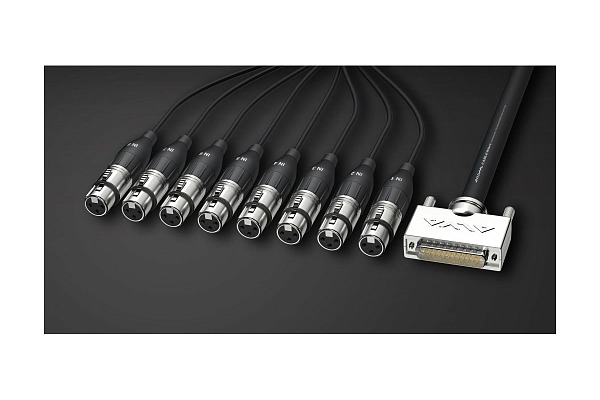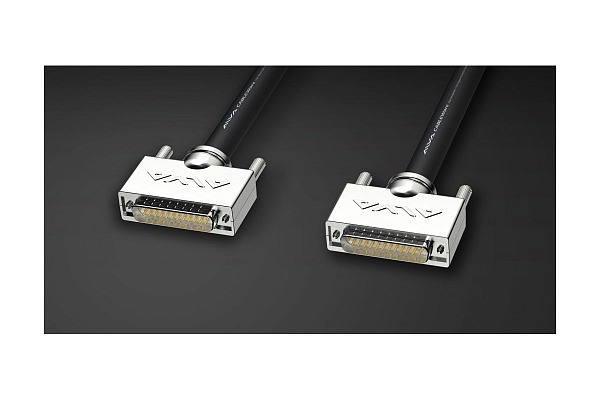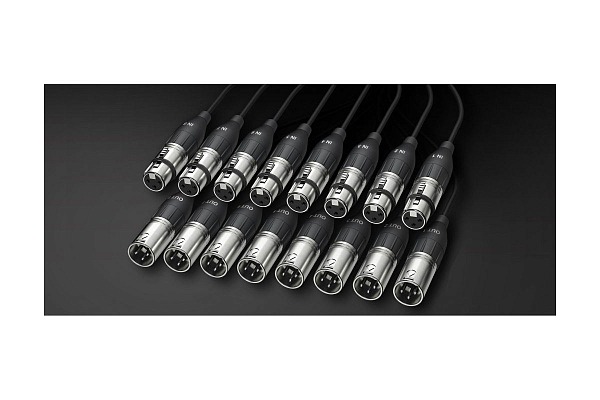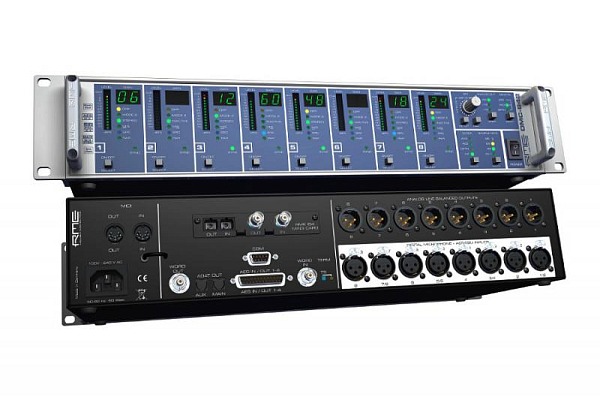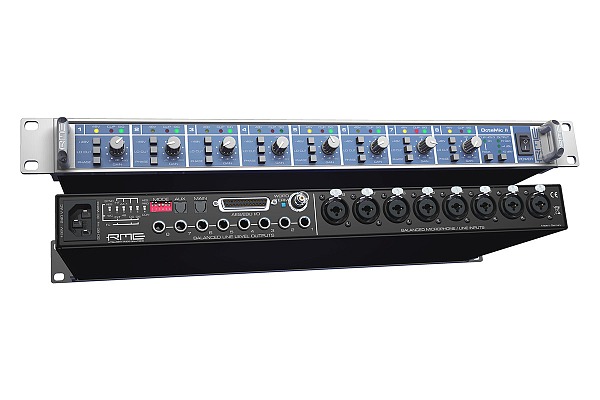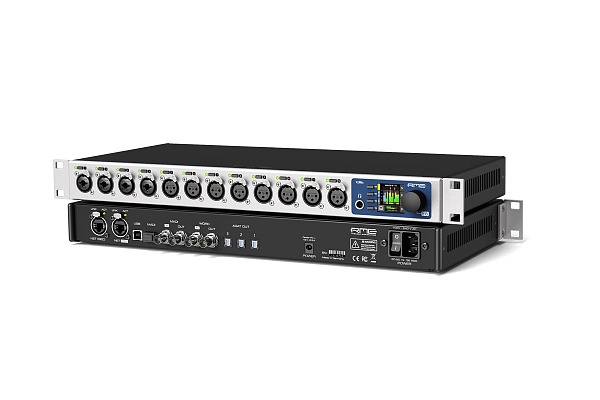RME
MICSTASY
8-channel full range
preamp & AD-converter
Connectivity and Features
- 8 x Analog Input Preamps
(XLR/Line with 85 dB Gain Range) - 8 x Analog Output (XLR)
- 4 x AES/EBU Out (8 channels @ 192 kHz)
- 2 x ADAT Out (8 channels @ 96 kHz)
- 1 x WordClock I/O
- 1 x MIDI I/O
- optional: MADI I/O (I64 MADI Card)
- AutoSet Digital Gain Control
Micstasy is an 8-Channel hi-end mic/line preamp and AD-converter combining typical RME features with a number of previously unseen features. It can be used analog (Mic/Line In to Line Out) and digital (Mic/Line In to Digital Out), with both signal paths operating simultaneously. Special highlight: the device is fully remote-controllable via MIDI (also MIDI over MADI).
The Micstasy's innovative concept allows for amplification and digitization of ALL analog signal sources. Be it high-level stage signals, typical studio signals, lower level and high-impedance instruments, or dynamic, condenser or ribbon microphones: Micstasy understands them all - in a way that is simply thrilling.
The signals amplified by the Micstasy are available at the analog outputs for passing them on, making an expensive splitter box on stage obsolete. All functions can be remote controlled via MIDI and MIDI over MADI, allowing the device to be placed near the microphones, ensuring highest sound quality. Adding the optional MADI Card results in even more options. The I64 MADI Card provides serial pass-through capability from one Micstasy to the next (up to 8). All up to 64 audio signals are then available at the last device on one single line. Such a way of cascading is also possible between Micstasy and ADI-8 QS.
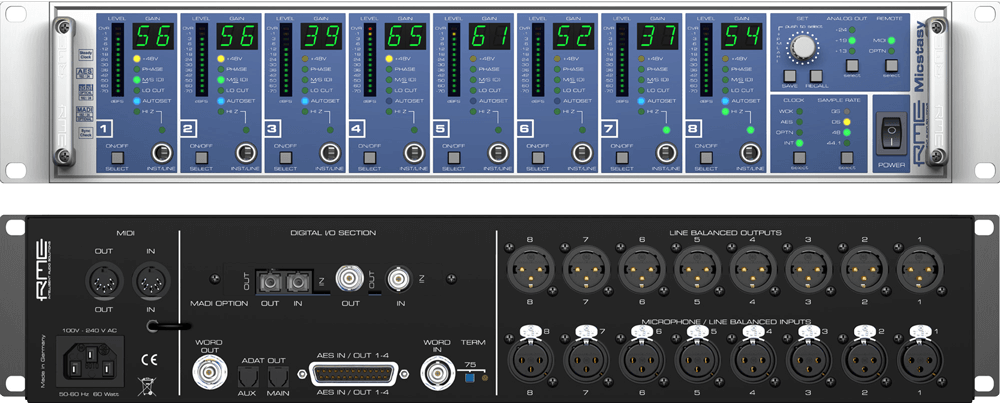
The Micstasy's most importent features:
- 8 balanced XLR mic/line inputs with 85 dB gain range
- Analog input level from -56.5 dBu up to +30 dBu
- High-end circuitry with 4 relays per channel, super low-noise microphone front-end
- Near click-free gain changes in steps of 0.5 dB
- Large frequency range (200 kHz) with special EMI input filtering
- 8 balanced TRS line / instrument inputs with Hi-Z option
- 8 balanced XLR line outputs, maximum level +27 dBu
- 4 x AES/EBU Out via D-sub, 8 channels @ 192 kHz
- 2 x ADAT Out, 8 channels @ 96 kHz (SMUX and SMUX4)
- Optional MADI I/O (I64 MADI Card) with serial cascading and digital return path
- Symmetrical hi-pass (Lo Cut) with super-low THD, 18 dB/oct
- LED level meter with 13 LEDs per channel
- M/S de-/encoding for the digital output
- AutoSet: Automatic gain reduction with multiple linking
- Current state can be stored to 8 user presets
- Fully remote controllable
RME's SteadyClock(TM) guarantees excellent clock quality in any situation. Due to the highly efficient jitter reduction, the Micstasy's AD-converters operate independently from the quality of the external clock signal, as if they are working with internal clock all the time - guaranteeing a pristine sound quality! Additionally Intelligent Clock Control (ICC) will retain the last valid sample frequency in case of a loss of the input signal.
Low latency
Autoset
Tech Specs
- Frequency response -0.1 dB: 20 Hz - 100 kHz
- EIN @ 30 dB Gain @ 150 Ohm: 122,3 dBu
- EIN @ 40 dB Gain @ 150 Ohm: 126,5 dBu
- EIN @ 50/60/70 dB Gain @ 150 Ohm: 127,4 dBu
- THD+N @ 30 dB Gain: < -100 dB, < 0,001 %
- Signal to Noise ratio AD (SNR) @ +30 dBu: 115.2 dB RMS unweighted, 118.5 dBA)
- Signal to Noise ratio AD (SNR) @ +21 dBu: 112.7 dB RMS unweighted, 116 dBA
- Signal to Noise ratio AD (SNR) @ +13 dBu: 110 dB RMS unweighted, 113 dBA
- Sync sources: Internal, AES, word, Option (MADI)
- Sample frequencies: 44.1 kHz, 48 kHz, 88.2 kHz, 96 kHz, 176.4 kHz, 192 kHz, variable (external clocks)
- Sample rate range: MADI: 32 - 192 kHz, word clock: 27 kHz - 200 kHz, AES: 28 kHz - 200 kHz
- Jitter: Typical < 1 ns for internal, word clock, AES and MADI input
- Jitter suppression: >30 dB (2.4 kHz)
- Jitter sensitivity: all PLLs operate error-free even at 100 ns
- Power supply: Internal switching mode PS, 100V - 240V AC, 60 Watt
- Dimensions: (WxHxD) 483 x 88 x 200 mm



